Oil Creek Tunnel
Pikes Peak, Colorado
Part 1: To the Tunnel
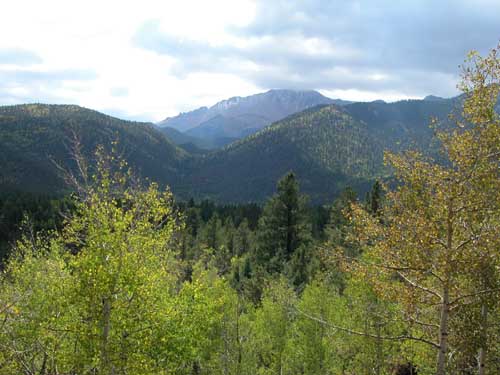
Fall Colors on Pikes Peak - September 14, 2002
This was taken from the 8 mile point on the Pikes Peak Highway
By Matt Carpenter
www.skyrunner.com
The Question
On September 14, 2002, Larry Miller and I headed up Pikes Peak on a mission. It was overcast but where we were going it didn’t matter.
We were going to explore the Oil Creek tunnel. I had been in the tunnel once before, about 10 years ago, but did not have a camera with me.
This page, although a much smaller version, was put up soon after I took a picture of the entrance in 1997.
In 1999, while doing research on the first running race up Pikes Peak back in 1936, I came across
several stories about the tunnel. However since this page was more about getting to the tunnel than about the tunnel I pretty much left it as it was.
Then, on September 7th, 2002, a couple of friends explored the tunnel and one of them came back with some questions. While the stories answered his
questions (when and why was it built?) they left me with a question of my own:
How deep is the Oil Creek tunnel?
I finally had my excuse to head back into the mountain! This updated page is the result:-)
The Research
Before we head out the door lets start with those stories I found. The first was from
the December 12, 1937, Gazette and Telegraph, now called The Gazette, and read as follows:
Oil Creek Tunnel into Pikes Peak to become tourist attraction
Pikes Peak’s famous Oil Creek tunnel, which has been seen by few people, will be another big attraction next year when the forest service builds its trail there.
Two miles off the main highway, at an elevation of 11,000 feet, is a tunnel going 800 feet into the solid granite of the mountain.
The tunnel is virtually unknown, altho it has been there since 1890, when a group of Cripple Creek mining pioneers started boring it.
Forestry officials plan to construct a small trail leading form Glen Cove, “resting place” on the peak highway, to the tunnel, which is not easily accessible at present.
The tunnel was driven by mining men who were seeking a short cut thru the mountains from Cripple Creek. The prospectors hoped to overcome the necessity of hauling their ore over narrow and steep roads from Cripple Creek to smelters at Colorado Springs.
Blocked by the hard granite in the mountain, the miners gave up the task after penetrating 800 feet. The tunnel is six feet high and from eight to 10 feet wide.
It is believed the miners hoped to defray expenses of the task by selling ore which they would find in driving the tunnel. However, the rock was not ore-bearing.
The tunnel was driven in the northeast face of Pikes Peak and had it been completed would have penetrated four miles thru the peak to a point near Gillette, in the Cripple Creek area.
Construction of the trail to the tunnel is one of several improvements being carried out in the vicinity of Glen Cove on the automobile highway. The Peak, which formerly was privately owned, is under government management and several improvements are proposed.
Construction of the trail, in addition to making accessible the tunnel, will give visitors an opportunity to study timberline varieties of trees, flowers and other plants.
The tunnel, which was named Oil Creek, is in the center of an area used by a heard of 30 mountain bighorn sheep for grazing. Visitors will be able to see this heard, which is one of the few groups of this vanishing species in Colorado.
Many deer roam the area in the summer months and it is believed persons taking the trail to the tunnel will catch glimpses of them.
The Oil Creek tunnel is located in one of five basins, known as ice cirques, caused by glacial action.
Glen Cove is located in one of the basins and the others are named Severy, Bottomless Pit and Crater.
It is planned to construct a trail to the crater basin, two miles northwest of Glenn Cove, which is not easily accessible at present. Known as the “crags,” this area is filled with picturesque rock formations similar to the Garden of the Gods in Colorado Springs.
Plans on the development of the region near Glen Cove have been prepared by H. J. Hanson of the forest service. The Ski trails and other winter facilities were laid out by Robert Balch, Denver skier, who is associated with the forest service.
|
Apparently the ski area did get constructed but if you have been up there you know it has long since been abandoned. At any rate, a week later on December 19, 1937, the following story appeared:
Oil Creek Tunnel was only prospecting venture, says pioneer; is 1,700 feet long.
New facts about the famous Oil Creek tunnel into Pikes peak which is to become a tourist attraction next year with the opening of the new trail there were brought to light last week in a letter to The Gazette and Telegraph from Ed Armentrout, pioneer resident of Green Mountain Falls, Mr. Armentrout says:
“I have been in this region since 1835, and was here all the time that work was in progress on the tunnel, was very familiar with and acquainted with many men that worked in it.
“It is ridiculous to believe that it could or was intended to be used to haul ore from Cripple Creek as, if it had been extended thru the peak, it would have come out at an altitude of about 11,000 feet, 2,000 feet higher than Cripple Creek, and about five miles from it, and in the roughest, most inaccessible part of the peak.
“This tunnel was financed, according to information available at that time, by Cincinnati capital.
“It was said then by the promoters, to be purely a prospecting venture, and as a reason for boring so far in solid granite without a lead or vein, or any mineral indications, they said that they found some rich “float” above on the surface and on the Oil Creek slope, and hoped to cut an ore deposit in the tunnel.
“I knew many men that worked in the tunnel and they said it was in about 1,700 feet instead of 800.
“In addition, I will add, that there was a wagon road built from the old Pikes peak carriage road from the lower point of the W, along about timber line, which was used to haul in heavy machinery, including an air compressor and boilers. This road is still there but most of it is filled with gravel slides and rocks.
“A pack train of burros carried supplies from Cascade over a trail up ‘Severy’ gulch.
“Several men were killed during the years it was in operation and they were packed out on burros.
“At one time, on account of extra deep snow, two were put on ice in a snow bank, until travel could be resumed on the trail.”
|
Adding to this tale was yet another letter that appeared the following week on December 26, 1937:
That Oil Creek Tunnel story started pioneers’ memories; two projects great fiascos.
The Oil creek tunnel, an old mining operation on Pikes Peak, a proposed forestry trail which is to be a tourist attraction, has become the subject of an historical controversy. No one knows the thousands of dollars lost in the venture. An account of it given by Ed Armentrout, of Green Mountain Falls, in last Sunday’s Gazette and Telegraph is followed up by a somewhat different account by Elmer Kendall, 517½ North Royer street, Colorado Springs, who worked on the tunnel. He writes the Gazette and Telegraph as follows:
“In 1898 Charlie Phay had a contract to drive the Red Cross tunnel 400 feet on the south side of the peak, at timberline. He took a winter’s supply up the cog road in October. Before Christmas he gave each man a half day off to make skis to return home for the holiday. The next spring he split up his crew and packed in the necessary tools to start work on what you call the Oil creek tunnel. We did not get to the old log shack the first day, so had to shovel off the snow and make camp. Our roof was the starts. But the next evening we got to the cabin, wet to the hips and dog tired. This was in March, 1899. Work was started, road work and the building of cabins. The snow where the first cabin was built was 12 feet deep. Charlie Phay, who lives at 12 West Rio Grande street, was in full charge of all work until Sam Couples was put in charge, Mr. Phay refusing to stay. Later he had full charge of the Copper King south of Canon City.
“Those losing their livers were Sam Couples and Jack Johnson. But there was no need of carrying them out on burros, as a wagon road was built. As for burying a couple of corpses in the snow, I cannot believe that. These were all seasoned men and could cope with whatever might happen. I do know of a man who was en rout from Cripple Creek to Colorado Springs and fell over Lovers’ Leap and was not found until the next spring. As for the tunnel being in 1,700 feet, Mr. Phay and I myself do not think it was longer than about 800 feet. Oscar Sammons was the manager, and a man by the name of Hoover, manager of the Red Cross on the south side of the peak. Both tunnels were owned by Cincinnati people and Charlie Phay was in charge of both tunnels. I worked for this company in 1897, then under Mr. Phay in 1898 and the spring of 1899.
“The longer of these tunnels is said to have been made to tap a vein of fluorine quartz on Little Pikes peak, just north of the peak. The south tunnel, 500 feet long, is off Windy point on the Cog road up Pikes peak.
|
So just as before there are three major questions (but now we have some answers):
- Why was the Oil Creek tunnel built?
My 1997 page went with the shortcut to Cripple Creek theory based on hearsay and what was being tossed around Barr Camp. In fact, before former Barr Camp
caretaker Chuck Wilt put up his website I used to host his Pikes Peak Tunnel Tour
on Skyrunner.com.
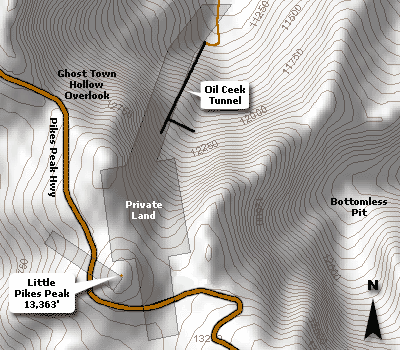
The main tunnel is headed for Little Pikes Peak. It would have taken 3.5 miles of tunnel to go through the mountain in this direction.
|
At any rate, Armentrout clearly says that the Cripple Creek shortcut theory is “ridiculous.” I think there are several
things that help back that assertion up. First, Kendall did not refute that claim even though he did refute several others.
Next, using the Pikes Peak Atlas as a guide, I have outlined and shaded an area of private land that extends
from the tunnel entrance to the other side of the Pikes Peak Highway with a big area just to the
north of 13,363' Little Pikes Peak. Next, I measured a compass heading of 196º (206º True North) for the tunnel which, as you can
see on the map to the right, has the tunnel heading towards that same large area of private land. This would seem to validate
Kendall’s claim that they were trying to tap a vein of fluorine quartz to the north of Little Pikes Peak. Finally,
if they were to continue in the direction they were going until coming out at the same elevation they
would have had to bore 3.5 miles to do so! This would have put them about 1 mile above Cripple Creek Reservoir
#3 in the West Fork of the West Beaver Creek drainage. This would have had them going about 400' under the Wilson
Reservoir #8 drainage as well.
Therefore, while it is hard to scrap the Cripple Creek shortcut theory, (its just such a good story, but that’s
probably why it gets told) based on the above I would have to say the theory is on its last legs. I am now convinced
that this was just a prospecting venture. However now that I have some more dates (the date of the accident) it would
be interesting to return to the library to see what the paper had to say about the tunnel while it was being built instead
of 38 years later.
- When was the Oil Creek tunnel built?
I had no clue but in one story we have 1890 and in another 1899. Again we have to give credence to Kendall. Although 38 years had passed when he
wrote his letter I would think a person could track down within a year or two what he was doing and when. However in this case we have more to go
on. If you do a Google search on “Oil Creek Tunnel”
besides this page (which at the time of this writing came up #1:-) there are a couple of pages at the end of the list (again, at the time of this writing) from the Denver Public Library listing mining deaths.
Among those listed are Samuel L Cupples
and Walter B Johnson with both listed as being killed at the Oil Creek
Tunnel with the cause of death listed as “struck/picked unexploded powder.” Although Kendall’s letter above had a slightly different spelling for
Cupples and a different first name for Johnson (not bad considering those same 38 years that had passed) I think this shows that Kendal was someone who knew what he was
talking about. Sealing the deal was the date listed for the mining accident: October 26, 1899. I think this validates Kendal’s account that the Oil Creek Tunnel was started in the Spring of 1899.
- How deep is the Oil Creek tunnel?
I had 2,300' on my page, which again was based on local lore. As for the stories, one says 1,700' and two say 800' and one of those stories was by the same man who claimed
to have helped build the tunnel. However since I had been in the tunnel I knew that it was a lot longer than 800'! Also, if you read carefully, Kendall worked
the tunnel in the Spring of 1899 and much of what he was writing about took place after he left. It could well be that when he left the tunnel was only 800' long. Clearly however the only way to answer this question was to measure the tunnel:-)
The Fieldtrip
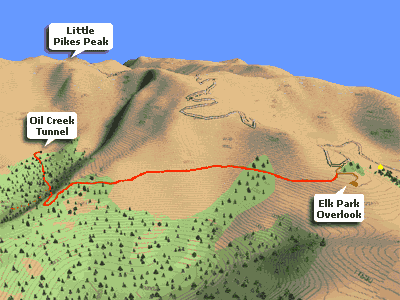
The yellow dot on the far right is Glen Cove.
This is where they check your brakes on the way down.
|
The easiest way to get to the Oil Creek tunnel is to drive up the Pikes Peak toll-road
to the Elk Park Overlook, which is just before the 14 mile mark. The Elk Park turn-off is 9/10s of a mile past
Glen Cove and is rather hard to spot until it is almost too late.
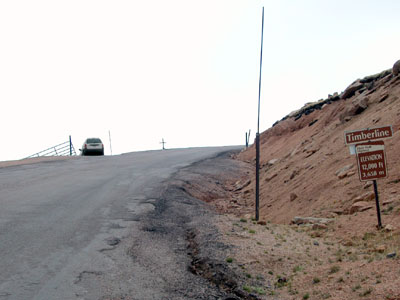
Larry takes the dive over the edge of Pikes Peak to Elk Park.
Note the Timberline 12,000' sign not quite a mile past Glen Cove.
|
The turn-off is just 50 yards or so past the Timberline (12,000') sign. Look for a couple of posts on your left and turn in between them keeping the gate to your left
and the pole to the right. Larry, being the jokester he is, likes to start swerving his car like he is losing control before he gets to the turn-off and then
he flies over the edge. More than a few tourists have stopped only to discover it was not a crash but just someone taking an exit off of the highway.
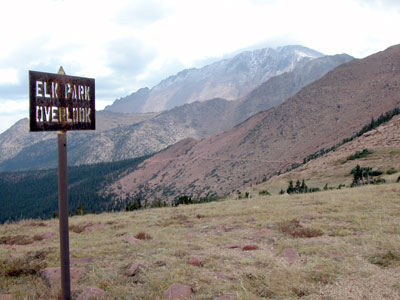
A parking lot with a view — the Pikes Peak Elk Park overlook.
If you look careful you can see the Elk Park Trail in the center.
|
There is plenty of parking at the Elk Park Overlook. The Elk Park Trail trailhead is at
the low point of the road near the sharp left turn you made to get up to the parking lot. This is right at 11,850'.
The first 3/4 mile of the trail is on the side of a scree field (you can see the trail in the picture on the right) with some great views
of Colorado Springs. There are 4 really bad washouts but they are easy to get through if you are watching your footing and not the view. Once you get
into the trees at about .8 mile you will only have another .1 mile to go before you take a left-hand turn.
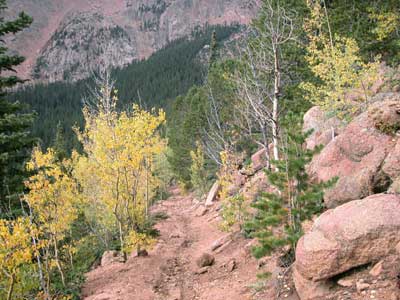
Awesome views but you need to watch your step.
Oil Creek Tunnel is pretty much straight-ahead at treeline.
|
In about another 1/4 mile you arrive at a sharp rocky right-hand switchback, which will have you heading west towards Pikes Peak. Again the views are awesome but I recommend you stop to take a look. More than a few runners (including myself) have bit it on this stretch of trail because the switchback is .2 mile long and remains steep and rocky. Hard to believe this used to be a wagon road!
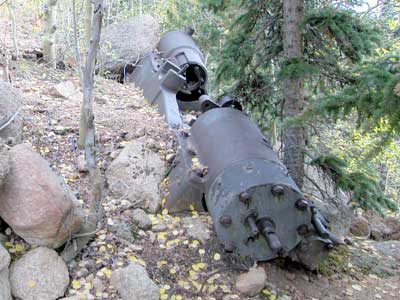
Not on my back you don't! I can't imagine trying to take
this thing into or out of the area on this trail
|
Three fourths of the way down the switchback on your left is a huge piece of machinery. My best guess is that when the mine was closed down they tried
to take some of the equipment out of there. If you tap on this thing with a rock you will get a feel for just how heavy it is and why someone left it on the side of the trail.
If you miss it on the way to the tunnel it is much easier to spot on the way out.
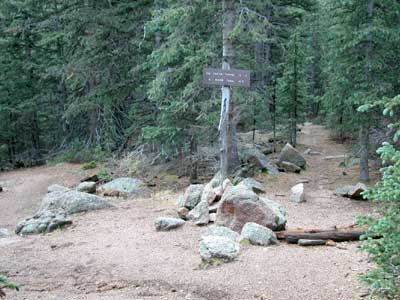
Since you are going to the Oil Creek Tunnel head straight over the logs that have been placed to lead people towards Barr Camp
|
At the bottom of the switchback at 11,100' and 1.4 miles from the trailhead the trail forks and there is a sign indicating that if
you go straight it is 1/2 mile to the Oil Creek Tunnel. In reality it is just shy of .4 of a mile. Some people doing the Elk Park Trail
for the first time trying to get to Barr Camp end up going towards the tunnel by accident because they miss the left fork which would take them to the camp after almost 4 miles of a trail that
is one of my favorites! On that note, if cars and toll roads are not your ideal
of an adventure you could also get to this point by running up the Barr Trail and hanging a right at Barr Camp to run UP to this point.
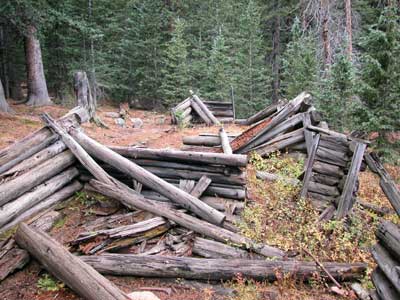
Cabin remains to be seen on the trip to the Oil Creek Tunnel
|
On the way to the tunnel you will pass by the remains of several cabins. I love looking around old cabin remains and despite the claims of the newspaper stories there are still
plenty of things to see and find. Unfortunately however a lot of it is just old trash. On this trip there were several piles gathered alongside the trail. There were also some
orange flags marking some of the cans. I think this means the Forest Service is out surveying artifacts again.
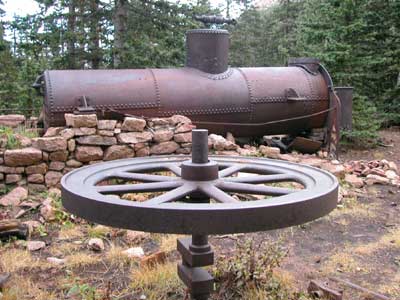
The steam boiler and equipment at Pikes Peak's Oil Creek tunnel
|
On the outside of the Oil Creek tunnel there is a massive steam furnace and some other equipment used to run the operation, which built the tunnel. The wheel used to be inside of a rather large cabin. You can't tell that now but there is a picture of the cabin remains in one of the newspaper stories from above.
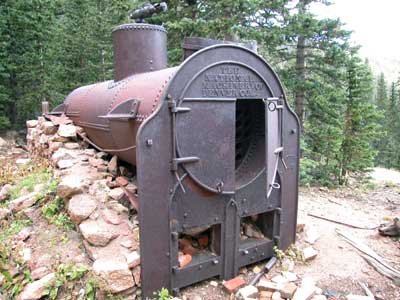
The writing above the doors reads
THE NATIONAL MACHINERY CO DENVER COL.
|
Now it could be argued that this thing may have been brought here in pieces but even so some of the pieces are huge. Again, another tap or two with a rock and
you will be convinced that it is not made out of soda pop can aluminum!
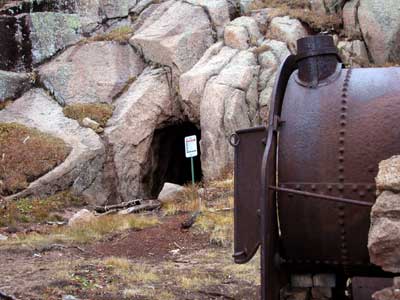
The entrance to the Oil Creek Tunnel is not far from the steam boiler
|
OK, enough of the diversions. I know you are here for the tunnel. Not far from the steam boiler is the entrance to the tunnel. It is at an elevation of 11,285'.
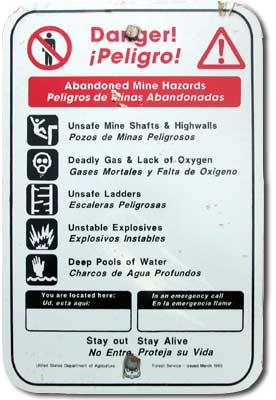
Well, that about says it all...
Click the sign to enter the tunnel!
|
WARNING!
Just because I have
been in the Oil Creek tunnel, and have put up a story and photos about it, that does NOT mean that I am saying it is OK to go into the tunnel!
Read the sign posted outside of the tunnel and make up your own mind!
Click the sign to enter tunnel!
Click here to go somewhere else!
|












